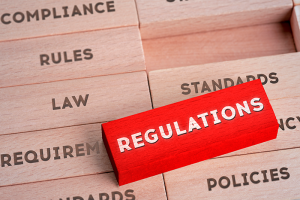Accreditation survey preparation advice

Accreditation surveys are comprehensive evaluation processes to ensure health care organizations meet specific standards of quality and safety.
Image by Getty Images
Hospitals and other health care facilities are highly regulated. Multiple entities — both governmental and voluntary — inspect hospitals and health care facilities and regulate their functions. At any time, an authority having jurisdiction (AHJ) can enter a facility to perform an inspection related to its accreditation.
A health care accreditation survey is a comprehensive evaluation process that health care organizations undergo to ensure they meet specific standards of quality and safety. Accreditation surveys are essential for maintaining high standards in health care and ensuring that patients receive safe and effective care.
The accreditation process for hospitals and other health care facilities can include but is not limited to:
- On-site evaluation. Trained surveyors visit the health care facility to assess compliance with established standards. This includes reviewing documentation, observing practices, and interviewing staff and patients.
- Standards compliance. The survey focuses on various aspects of health care delivery, such as patient care, medication management, infection control and the physical environment.
- Performance improvement. The survey aims to identify areas for improvement and help organizations enhance their quality of care and patient safety.
- Unannounced surveys. Accreditation organizations (AOs) conduct unannounced surveys to ensure that organizations maintain standards continuously. It is the policy of the Centers for Medicare & Medicaid Services (CMS) that, with few exceptions, all surveys to verify compliance (or “substantial compliance” in the case of nursing homes) are to be unannounced for all providers and suppliers participating in CMS programs. This includes standard surveys, complaint surveys and on-site revisit surveys.
- Accreditation decision. Based on the survey findings, the AO makes a decision that can range from full accreditation to conditional accreditation or denial of accreditation.
CMS standards
CMS is a federal agency within the Department of Health and Human Services. It plays a crucial role in ensuring that the nation’s major health care programs, including Medicare, Medicaid, the Children’s Health Insurance Program and the health insurance marketplace, operate efficiently and effectively to improve health care quality, equity and outcomes across the U.S.
Resources
Toward that end, CMS sets standards for health care facilities participating in the Medicare and Medicaid programs. These standards, known as Conditions of Participation (CoPs), cover various aspects of health care delivery and are essential for accreditation. Key CMS standards include:
- Patient rights (42 CFR §482.13). Facilities must protect and promote patient rights, including privacy, informed consent and the right to receive care in a safe environment.
- Quality assessment and performance improvement (QAPI) (42 CFR §482.21). Facilities must develop and implement a QAPI program to continuously monitor and improve the quality of care.
- Infection control (42 CFR §482.42). Facilities must establish and maintain a program to prevent and control infections.
- Physical environment (42 CFR §482.41). Facilities must ensure a safe and functional physical environment, including fire safety, emergency preparedness and maintenance of equipment.
Deemed AOs
Health care organizations seeking to participate in and receive payment from the Medicare or Medicaid programs must be certified as complying with the CoPs or standards set forth in federal regulations. This certification is based on a survey conducted by a state agency on behalf of CMS.
However, if a national AO enforces standards that meet the federal CoPs, CMS may grant the AO deeming authority and deem each accredited health care organization as meeting the Medicare and Medicaid certification requirements. The health care organization would have deemed status and would not be subject to the Medicare survey and certification process because it has already been surveyed by the AO.
Accreditation is voluntary, and seeking deemed status through accreditation is an option, not a requirement. According to CMS, Section 1865(a)(1) of the Social Security Act permits providers and suppliers “accredited” by an approved national AO to be exempt from routine surveys by state survey agencies to determine compliance with Medicare conditions. Accreditation by an AO is voluntary and not required for Medicare certification or participation in the Medicare program.
Multiple national AOs offer accreditation programs recognized by CMS for the purpose of certifying the compliance of hospitals, critical access hospitals, ambulatory surgery centers, home health agencies and hospices with Medicare health and safety standards.
The following organizations have deeming authority for various types of health care facilities:
- Accreditation Association for Ambulatory Health Care
- Accreditation Commission for Health Care Inc.
- American Association for Accreditation of Ambulatory Surgery Facilities
- Center for Improvement in Healthcare Quality
- Community Health Accreditation Partner
- DNV Healthcare USA Inc.
- The Compliance Team
- The Joint Commission
Although the survey and accreditation process varies among the AOs, they all will be looking for very similar areas of compliance. CMS may inspect a facility even if it has already been accredited by one of the other agencies. Representatives may show up at any time, without advance notice, so facilities must always be survey ready.
Other authorities that inspect hospitals and health care facilities include, but are not limited to, state or local fire marshals or inspectors, state departments of health, local fire department inspectors, other local AHJs, insurance inspectors, the Occupational Safety and Health Administration and the Environmental Protection Agency, which evaluates environmental impacts, such as what goes into the waste stream.
A comprehensive approach
Accreditation surveys are critical for health care facilities, ensuring they meet established standards of quality and safety. For health care facilities professionals, preparing for these surveys involves a comprehensive approach that includes these key elements:
Understanding accreditation standards. The first step in preparing for an accreditation survey is to thoroughly understand the standards set by CMS and the AO. These standards cover various aspects of health care delivery, including patient care, medication management, infection control and the physical environment. This process includes:
- Familiarization. Facilities professionals should thoroughly review the accreditation standards relevant to their facilities. This includes standards from The Joint Commission, DNV Healthcare or other AOs. Organizations like The Joint Commission and DNV Healthcare provide a comprehensive accreditation manual that outlines all the standards and elements of performance. The manual can be an essential resource for preparing for accreditation.
- Training. Facilities professionals should attend training sessions or workshops on accreditation standards and survey processes.
Conduct self-assessments and mock surveys. Once facilities professionals understand the requirements, they should conduct self-assessments and internal mock surveys to identify areas for improvement. These include:
- Internal audits. Facilities professionals should regularly conduct internal audits to identify areas of non-compliance and opportunities for improvement. Performing a self-assessment is crucial in identifying areas that need improvement. This involves reviewing the facility’s policies, procedures and practices against accreditation standards.
It’s important for facilities professionals to involve staff from various departments in this process to get a comprehensive view of the facility’s compliance. Based on the results of the self-assessment, professionals should develop an action plan to address any gaps in compliance. This plan should include specific actions, responsible individuals and timelines for completion. The action plan should be regularly reviewed and updated to ensure progress is being made.
- Mock surveys. Facilities professionals should perform mock surveys to simulate the actual accreditation process. This helps staff get accustomed to the survey procedures and identify any areas for improvement prior to the accreditation survey.
Documentation and recordkeeping. Facilities should maintain accurate documentation. Tasks include:
- Organize records. Facilities professionals should ensure all documentation, including policies, procedures and patient records, are complete, accurate and easily accessible.
- Update policies. Facilities professionals should regularly review and update policies and procedures to align with current standards and best practices.
Staff training and engagement. Finally, facilities should continuously educate and train staff on the requirements for accreditation. This includes:
- Educate staff. Facilities professionals should provide ongoing education and training for staff on accreditation standards and their roles in the survey process.
- Engage leaders. Facilities professionals should involve key leaders and department heads in the preparation process to ensure a coordinated effort. Leadership engagement is essential for successful survey readiness. Leaders should be actively involved in the preparation process and demonstrate a commitment to meeting accreditation standards. This includes providing the necessary resources and support to staff and fostering a culture of quality and safety.
Survey readiness is an ongoing process that requires continuous monitoring and improvement. Facilities professionals should regularly review their facility’s performance against their AO’s standards and implement changes as needed. They should foster a culture of continuous improvement and encourage staff to identify and address areas for improvement.
Areas of focus
Certain areas are scrutinized during accreditation surveys. Focusing on these can help ensure compliance and improve overall quality and safety. They include:
- Infection control. Facilities should implement and monitor strict infection control practices, including hand hygiene, sterilization and environmental cleaning.
- Medication management. Facilities should ensure safe and compliant medication storage, labeling and administration.
- Patient safety. Facilities should promote patient safety initiatives, such as fall prevention, accurate patient identification and emergency preparedness.
- Physical environment. Facilities should maintain a safe and conducive physical environment, including fire safety, electrical safety and hazardous materials management.
Common findings
Accreditation surveys often reveal common areas of non-compliance. Understanding these findings can help health care facilities professionals proactively address potential issues. They include:
- Incomplete documentation. This includes missing or incomplete documentation such as patient records, policies and staff training records.
- Infection control lapses. This includes lapses in infection control practices such as improper hand hygiene and sterilization or, in areas designed to control airborne contaminants (e.g., biological agents, gases, fumes and dust), the ventilation system does not provide appropriate pressure relationships, air-exchange rates, filtration efficiencies, relative humidity or temperature.
- Medication errors. This includes issues related to medication storage, labeling and administration.
- Environmental safety hazards. This includes unsafe physical environments, including blocked fire exits and improper storage of hazardous materials.
More specific to the health care facilities management function are the following common health care accreditation survey findings:
- Utility systems. This includes problems with the maintenance and operation of utility systems, including heating, ventilating and air-conditioning systems, electrical systems and medical gas systems.
- Means of egress. This includes issues related to safe and unobstructed exit paths in case of an emergency, such as blocked exits or improper signage.
- Physical environment. This includes deficiencies in the physical condition of the health care facility, including damaged walls, ceilings and floors, that can affect infection control and fire/smoke barrier effectiveness.
- Fire protection. This includes non-compliance with fire safety standards, including issues with fire alarms, sprinkler systems and fire doors.
- Documentation and recordkeeping. This includes incomplete or missing documentation for life safety inspections, maintenance and testing.
- Medical gas systems. This includes non-compliance with standards for medical gas storage and handling, including improper labeling and inadequate ventilation.
- General requirements. This includes general life safety code violations such as improper storage of hazardous materials and inadequate fire drills.
Ensuring compliance
Health care facilities continue to be increasingly complex, requiring managers to have a combination of skills, knowledge and ability to effectively lead a multidisciplinary team that can identify, prioritize and resolve an ever-adapting list of issues.
The American Society for Health Care Engineering’s Core Competency Framework charts out key skills of health care facilities management and offers education, resources and tools to help facilities professionals fill knowledge gaps in each area.
Preparing for accreditation surveys requires a comprehensive and proactive approach. Regular maintenance, complete and accurate documentation, and continuous staff education and training are critical to ensuring compliance with life safety codes and standards.
By understanding accreditation standards, conducting self-assessments and mock audits, maintaining and standardizing documentation, educating and training staff, and focusing on key areas, health care facilities managers can ensure continuous compliance and improve the quality and safety of care.
Additionally, staying informed about frequently cited standards during surveys and findings from previous accreditation surveys can help facilities managers address potential issues and maintain readiness for accreditation.
RELATED ARTICLE: Resources for new managers to learn and excel in their jobs
New health care facilities managers have multifaceted roles that require a blend of technical knowledge, managerial skills and an understanding of health care regulations. Some effective ways they can learn and excel in their positions include:
Regulatory and compliance knowledge. Health care facilities professionals should familiarize themselves with health care-specific regulations and standards, including those from The Joint Commission, DNV Healthcare USA Inc., the Occupational Safety and Health Administration, and local health and fire departments. Additionally, facilities professionals can participate in training related to safety, compliance, environment of care, environmental regulations and infection control. Among available resources is the American Society for Health Care Engineering’s (ASHE’s) hosted programs.
Education and certification. Health care facilities professionals can enroll in courses related to health care facilities management, building systems and safety regulations. To build credibility and knowledge, they also may pursue relevant certifications such as Certified Health Care Facility Manager, Certified Health Care Constructor, Certified Health Care Physical Environment Worker, and Mechanic Evaluation and Certification for Health Care.
Facilities resources. Facilities professionals can join organizations like ASHE or ASHE Chapters to access resources, networking opportunities and continuing education. Additionally, they can read journals and publications such as Health Facilities Management to stay updated on trends, best practices and innovations. Accessible resources include the ASHE Member Tools Committee (formerly called the Member Tools Task Force) reference tool; compliance tools; the Developing Code-Compliant Integrated Fire Protection and Life Safety Inspection, Testing and Maintenance Programs book; and Understanding Health Care Compliance: The Facilities Manager’s Handbook.
Technology and systems training. Facilities professionals should learn to use facilities management software systems for maintenance scheduling, asset management and reporting. They also should gain knowledge about mechanical, electrical, plumbing, pneumatic tube and other critical building systems to manage them effectively.
Soft skills development. Facilities professionals should develop skills in leadership, conflict resolution and effective communication, as these are crucial for managing teams and interacting with other departments. Additionally, they should learn project management principles to handle renovations, upgrades and new construction projects. Resources include the ASHE Building Success in Health Care Project Management webpage and The Facilities Manager’s Handbook for Health Care Project Management.
Networking and peer learning. Facilities professionals should participate in conferences and seminars to connect with peers and learn about new challenges and solutions. Resources include the International Summit & Exhibition on Health Facility Planning, Design & Construction (PDC Summit), Health Care Facilities Innovation Conference™ and other educational opportunities . Facilities professionals also can engage in online forums and professional groups to discuss issues and share knowledge with other facilities managers, such as My ASHE.
Practical experience. Facilities professionals can take on small projects or tasks within the facility to gain hands-on experience and build confidence. Additionally, they should regularly assess and refine processes and procedures to improve efficiency and effectiveness.
Combining these approaches will help new health care facilities managers build a solid foundation and adapt to the complexities of their role effectively.
Frank D. Rudilosso, M.Eng, PE, CHSP, SASHE, is senior director for facilities maintenance operations programs at New York-Presbyterian Hospital in New York City. He can be contacted at frr9035@nyp.org.



